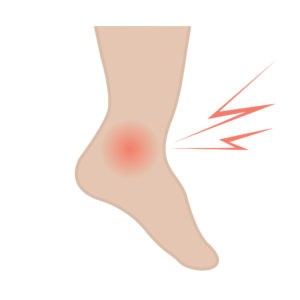 There are a number of different issues that can be present if you are dealing with pain on the outside of your ankle, but if you can rule out acute trauma or a sprain, one condition you are left with is sinus tarsi syndrome. The condition is categorized by acute and localized pain on the outside front part of your ankle, which is aptly named the sinus tarsi. So what causes this condition to set in, and how is it treated? We answer those questions in today’s blog.
There are a number of different issues that can be present if you are dealing with pain on the outside of your ankle, but if you can rule out acute trauma or a sprain, one condition you are left with is sinus tarsi syndrome. The condition is categorized by acute and localized pain on the outside front part of your ankle, which is aptly named the sinus tarsi. So what causes this condition to set in, and how is it treated? We answer those questions in today’s blog.
Causes and Symptoms of Sinus Tarsi Syndrome
There are a number of different causes of sinus tarsi, but they all share a similar pathology. They all involve damage, acute trauma or inflammation to the ligaments in the area. Many people develop the condition after repetitive ankle sprains, but foot characteristics can also contribute to walking patterns that create friction in the area, which can lead to ligament damage. Individuals with flat feet or pronated feet are more likely to suffer from sinus tarsi syndrome.
Symptoms of the condition include:
- Anterolateral ankle pain (outside of the foot)
- Swelling
- Symptoms that worsen when standing or walking
- Noticeable flatfoot deformity
- Pain when rotating the ankle or performing range of motion exercises
Diagnosing and Treating Sinus Tarsi Syndrome
As we mentioned above, there are a wide variety of conditions that result in pain in the outside of the foot, so a clinical examination has a goal of identifying the root cause of pain while ruling out some other common conditions, like peroneal tendinitis, tarsal coalitions or stress fractures.
During your examination, your doctor will ask about your symptoms and conduct some physical tests with your foot. They will be testing to see which movements reproduce symptoms, as well as looking for swelling or the presence of a flatfoot deformity. X-ray tests can help confirm a diagnosis because it can reveal an impingement in the area, while also helping to rule out other potential problems. An MRI may also be helpful by highlighting fluid and inflammation in the sinus tarsi.
Once diagnosed, your doctor will walk you through your treatment options. The condition responds well to conservative treatment options, and these methods usually focus on modifying activities to reduce friction or stress in the sinus tarsi. Common treatment options include switching to a more comfortable shoe, wearing an orthotic insert to better displace stress on your foot, bracing the ankle to protect the sinus tarsi or receiving a round of corticosteroid injections to quell inflammation that is contributing to the onset of pain.
Surgery to treat sinus tarsi is only considered for patients who have undergone weeks of unsuccessful conservative treatment. Surgery to treat the condition is rare, but in cases where it is needed, operating on the sinus tarsi is usually only half the battle. Since the condition is often worsened by a flatfoot deformity, oftentimes a foot surgeon will also have to perform a reconstruction of the foot in addition to the sinus tarsi debridement. Your doctor can explain what goes on during this procedure if it turns out you may best benefit from an operation.